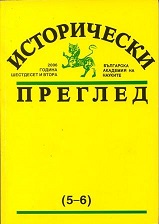Съвладетелството във Византия (XП-Х век) според данните на сфрагистиката
The Co-Rulership in Byzantium (7th to 10th Centuries) According to the Data of Sigillography
Author(s): Todor Raychev TodorovSubject(s): History
Published by: Институт за исторически изследвания - Българска академия на науките
Summary/Abstract: The paper aims to trace back the tendencies and characteristics of the Byzantine imperial iconography represented on the 7th–10th-century seals focusing on one particular aspect – the co-ruler’s images. The information from the Byzantine imperial seals containing co-ruler’s images has been grouped into the following three chronological sections according to both the available sigillographic material and the general political development of the Empire in the 7th to 10th centuries: 1. The co-ruler’s images from the period of the Heraclian dynasty (610–711) (Table 1); 2. The co-ruler’s images from the 8th to the late 9th century. (Table 2); 3. The co-ruler’s images from the period of the Macedonian dynasty for the period 869-1025 (Table 3). This brief overview of the representations of joint reigns on seals and coins during the most part of the Macedonian period, gives me grounds to outline two main tendencies. The first one is the continuity with the previous eras. It is manifested by keeping and even restoring some abandoned features of the iconography of the joint reigns. The second tendency is that of the changes. It is illustrated by the attempts at emphasizing the hierarchy through specific details of the depiction. The most conspicuous is the clear differentiation between the emperors’ official clothes. The senior emperor or the regent augusta appear in the stemma-divitision-loros combination, while the junior empreror/emperors wear stemma-divitision-chlamys outfit. Why was exactly this distinction made? Perhaps the answer can be found in the origin and symbolism of the loros itself. There is plenty of information in the literature on this subject but here I will confine myself to the fact that besides its associations with Christianity (discussed by Constantine Porphyrogenitos), the origin of the loros stems from the consular costume trabea triumphalis. Thus, by reserving for himself this symbol of executive power from the time of the Roman republic, the senior emperor demonstrated once again to his subjects that he was the actual ruler of the empire.
Journal: Исторически преглед
- Issue Year: 2011
- Issue No: 5-6
- Page Range: 255-264
- Page Count: 10
- Language: Bulgarian
- Content File-PDF

